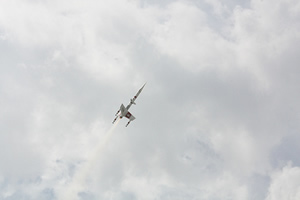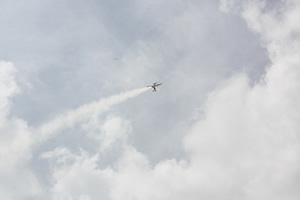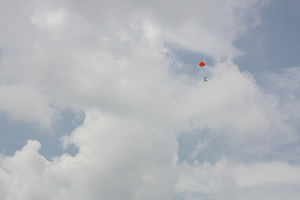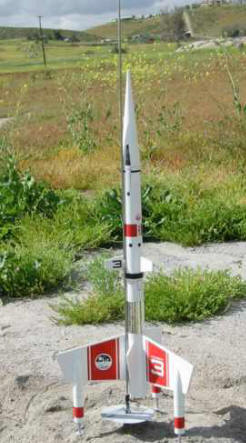| Construction Rating: | starstarstarstarstar_border |
| Flight Rating: | starstarstar_borderstar_borderstar_border |
| Overall Rating: | starstarstarstarstar_border |
| Manufacturer: | Qmodeling  |

Brief:
Upscale of an Estes vintage exotic kit.
Construction:
2 17" cardboard body tubes, 3 cardboard tubes for landing leg pods, steel springs for the shock-absorbing
landing legs, high-quality, laser-cut balsa fins and motor mount "exoskeleton," reflective, heat-resistant
coating inside 24 mm motor mount, steel engine retaining hook (long enough for a BP E-motor), resin main nose cone and
landing leg pod nose cones, laser-cut balsa centering rings and nose cone screw-eye attachment, Kevlar®
shock cord, nylon parachute, snap swivel, chute protector, water-slide decals, reflective peel-and-stick decal.
When I pulled the instructions out of the bag, I was intimidated! They consisted of a many-paged, stapled booklet of legal-sized pages. However, the instructions were very clear. The assembly instructions were broken-down into very small steps, each well-illustrated, which explains why the instructions were so long. Frankly, I greatly prefer to be walked-through a construction process with such detail, especially when it comes to a model as complicated as this one. The order of the steps was logical. I wouldn't change a thing about them.
Much has been said in other reviews about the unique motor mount/fin interface. In my case, the pieces for the MMT-exoskeleton fit together like a precision jigsaw puzzle. The illustrations clearly showed the up-down orientation of the pieces, but they only fit together in one way anyway, which made it "idiot-proof." After the fins were attached to the MMT, and the assembly was slid into the body tube, I noticed that there was a little bit of play to the fins; i.e., if I rotated the MMT, the fins would skew a bit from perfect 120 degree angles. In all honesty, if that play had not existed, it probably would have been impossible to insert the MMT. After applying glue, and sliding the assembly in, I rotated the MMT until the fins appeared to be perpendicular to the body tube, at least to "eyeball" standards. It was nice to not have to brace the main fins while the glue was drying. BTW, the shock cord attaches to the MMT exoskeleton.
Speaking of glue, I used white wood glue throughout the build, except for CA gel to glue the screw-eye bulkhead to the nose cone, as well as to glue the landing leg pod nose cones to the cardboard spring housings. I used the double-glue method to attach the auxiliary fins, lining them up by eyesight with the main fins, and using long strips of green masking tape to hold them in place while the glue set. Thin fillets of white glue were applied to the fins and to the launch lugs.
Finishing:
I taped off the shoulder of the nose cone, and the landing legs (to prevent paint from getting into the
"springy" works of the landing leg pods). I hit the whole model with an initial coat of Kilz primer. After
sanding with 380 grit, there was just a little bit of balsa grain visible, so I applied a second coat. Unfortunately,
the Kilz did something at that point which it has never done before, in that it left tiny bubbles on one side of one
main fin, as well as on all of the auxiliary fins. The bubbles quickly popped, of course, leaving pits in the finish.
Sanding did not remove the pits (well, I could have sanded down to bare wood, but considering the amount of
"lumber" on this model, that quickly exhausted me!). I tried another coat of Kilz, but the problem grew
worse. I mitigated the problem by applying a couple of coats of white glue, using cardstock to scrape the glue into a
smooth film, then lightly sanded. I applied two more coats of Krylon glossy white, sanding between coats. The pits in
the fins were much better, although still visible up close. I gambled that the application of the decals would help to
hide them.
The instructions called for spraying the water-slide decals with clearcoat before applying them to the model. I did so, using Krylon glossy clearcoat. After drying, I applied the decals. Even after clearcoating them, a couple of the smaller decals still tore, although the resulting cracks in the decals were hardly visible after shifting them back into the correct positions. The mirrored decal, which replaces the red body decal from the original kit, was a nice touch. As has been noted in other reviews, care must be taken with this decal, as handling it too much tends to cause the black printed "ribs" on the decal to crumble. This happened to me, although, again, it was barely visible, only upon close-up scrutiny.
Construction Rating: 4 out of 5
Flight:
I inserted a D12-3 and a E9-4 into the Vega, and verified that the CG was still in the proper place (as identified in
the instructions).


The maiden flights of the Vega were on Feb. 14, 2009. At that point, the Vega was still in primer. I launched it twice that day, on a D12-3 and a E9-4. The D12 boosted the Vega straighter, due to its more abrupt thrust profile. The thrust of the E9 tails off towards the end of the burn, which, in any kind of wind, causes the Vega to "flop over" onto its side and to fly horizontally for the last few seconds of flight, which is always unnerving. During the first flight, the shock cord and parachute hung up on a landing leg pod, so the parachute didn't fully deploy. Fortunately, the Vega landed in a loose tangle of dried vegetation, cushioning the blow. She was undamaged. During the second flight, the shock cord again hung up on a leg, but the parachute fully deployed. She landed horzontally, which kind of defeated the purpose of the shock-absorbing landing legs. Again, no damage, other than a landing leg pod popping off of a fin at the glue line. The spring was recovered, enabling a complete repair.
The Vega's third flight occurred on Mar. 21, 2009. By now, she had her "final" coat of glossy white (more on that later). She launched on a E9-4. Due to the almost nonexistent wind that day, she boosted straight up like an arrow. Unfortunately, the parachute wrapped around a landing leg again, and she dropped straight as an arrow onto drought-hardened soil. One of the fins was snapped off at the body tube joint, and two of the landing leg pods popped off; one of the pod tubes buckled noticeably, as did the lower body tube (right where the mirrored decal was to be attached). Back to the "shop" for an extensive refit.


Flight 4 occurred on Jun. 13, 2009. With the (truly) final coat of paint, cardboard reinforcement of the buckled body tube (covered by the mirrored decal), and the full set of decals, the Vega was resplendent in her glory. I had reattached the parachute to the nose cone screw-eye, rather than onto the shock cord, halfway between the nose cone and the top of the body tube, as specified in the instructions. She was packing an E9-4 again. The Vega weathercocked, but achieved a safe altitude. She had her best recovery yet, landing on her spring-loaded feet, although falling over on her side immediately thereafter. There was no damage.
Flight 5 occurred on Sept. 9, 2009. I had grown dissatisfied with the "puffy"-looking mirrored decal, so
had replaced it with a chrome-painted strip of corrugated styrene (to give the Vega a "ribbed" look, as
though it had "radiator panels" for its "reactor"). I tried a D12-3 again to see if this motor
minimized weathercocking. Nevertheless, the Vega flopped over on its side at altitude, although she didn't fly as far
away due to the shorter duration of the burn time. The shock cord caught on a leg, so she landed horizontally, although
without damage. This day, the Vega also survived an assassination attempt (within inches) by the power pod of a Cosmos
Mariner, which ejected same upon impact.

Recovery:
Nov. 14, 2009: ZIPPER! I had used an AT E15-4. I almost didn't get the motor into the MMT; the motor retention clip
caused a slight inner bulge, which I had to trim away with a hobby knife. In the process, a main fin fillet cracked; I
did a field repair with CA gel. In flight, the delay seemed longer than 4 secs. The ejection charge also made quite a
"bang." The Vega drifted back towards our club's GSE, and would probably have landed on top of us, had it not
drifted right into the side of John Lee's U-Haul truck. Sometime during this eventful flight, the Kevlar®
shock cord cleaved the body tube in twain, just below the auxiliary fins. A main fin also snapped off, as well as two
of the landing leg pods.
Throughout these flights, when the chute deployed completely, the descent rate and drift rate were just about perfect. The flame-retardant chute protector material has always done its job. It's a joy to not have to worry about wadding!
Flight Rating: 2 out of 5
Summary:
Pros: high-quality materials, unique motor mount/fin interface exoskeleton; great instructions; great flyer (in low
winds). IMO, this is one of the best upscales of a classic kit on the market.
Cons: be aware of the winds: this model carries a lot of "lumber." The motor mount may need to be of a thicker tubing to avoid the inner retaining clip bulge which caused me so much trouble with a composite motor (never an issue with BP motors). IMO, a model this heavy needs some sort of elasticity in the shock cord; perhaps this would have prevented the "zipper." The decals have not held up well, even after clearcoating as directed in the instructions.
Overall Rating: 4 out of 5
Other:
The Vega has been reassembled since her last flight. I intend to extend the ribbed "radiator" section to
hide some of the cracks in the airframe. Additional cracks will be hidden by decals (from Jimz Plans) printed on
cardstock. I blew up some of the original Vega decals from Jimz site 170%, and printed them out on business-grade paper
on a business-grade laser printer. They came out with vivid color and a glossy finish. I smeared an even film of white
glue on their backsides, and applied them to the Vega; she looks better than ever. I had intended to restore the Vega
for display only (she has always been one of my favorite models from the 70s, one I always lusted after in high school,
but never acquired then). However, I'll consider retrofitting her with some sort of "zipper-proof" shock cord
setup, and may fly her again.
![[NAR]](/images/archive/images/link_nartitle.gif)
![[Sport Rocketry]](/images/archive/images/link_sr_logo.gif)
The following excerpt is from "Sport Rocketry". The intention is to allow guests to get a basic feeling about a kit. We strongly suggest that you get a copy of the referenced Sport Rocketry and read the entire article. Inside you will find many helpful hints in construction as well as other useful information. For more information, use the two links above.
(Sport Rocketry - May/June 2006 - by Jon Skuba)
 |
| Courtesy of QModeling |
"...this QModeling kit is of the highest quality, well designed, and included
intelligently written instructions."
"...is 1.68 times larger than the original Starship Vega sold by Estes Industries in the 1970's."
"Its light-weight construction enables it to fly nicely on an E30 or F21."
"With over 60 components and 4 sheets of decals, the Vega may appear daunting..."
"...the easy to following instructions include numerous illustrations and are filled with hints and suggestions
to make the job go well..."
"More recent deliveries have been upgraded to include a Top Flight Recovery lightweight Nylon parachute,
Kevlar®
shock cord, and Nomex®
flash mitigation pad."
"The nosecone and landing gear pod nosecones are hollow cast urethane."
"All of the fins are made from 3/16" thick balsa wood."
"The vertical portions of the ingenious motor mount are made from 1/8" thick balsa wood while the rings are
from 1/8" Masonite, all laser cut..."
"The airframe tube is also laser notched for through the wall construction of the large main fins."
"The landing gear uses real springs for shock dampening."
"The assembly procedure is laid out in a logical 'divide and conquuer' stragety..."
"In the end, it took me about four hours of assembly."
""The six small fins (3 canards and 3 secondaries) are surface mounted."
"...worrisome is the possibility that lack of adhesion between the balsa fins and the ureghane landing gear
nosecones may end up leaving the outboard sections of the main fins unsupported and easily broken. Fortunately, Vega
would have to land almost on its side to cause such damage."
"To provide an attachment point on the tail endo fo the hollow cast nosecone, the kit comes with a Masonite disk
and a screw eye."
"For those that like finishing rockets, this bird presents a wealth of surfaces to sand, seal, and paint."
"Vega's first launch...the F21 power plant should have carried Vega little more than 1000 ft up... landed over
1/2 mile downrange."
"Landing the Vega with significant ground speed caused minor damage to one of the landing struts. Even with a
30" parachute..."
Overall, the article shows that this is an involved kit to build, great to look at, and interesting to fly. The author noted that he has also built other QModeling kits and believes the "Q" in QModeling is for Quality (Just as QModeling says).
Other Reviews
- Qmodeling VEGA By Chan Stevens
Brief: This kit is a beautiful upscale and upgrade to the Estes classic Starship Vega. Magnificently engineered and loaded with top-quality components and features, this rocket would be a great addition to any BAR's fleet. From what I can tell, upgrades to the original design include nose cones on the wing pods/landing gear, a fully functional set of shock absorbers in the landing gear, ...
- Qmodeling VEGA By Jeff Drongowski
QModeling of Temecula, CA has put together a great looking upscale remake of the old Estes Vega rocket. The kit has always been one of the more interesting looking "retro" rockets put in to flight and QModeling has done a fine job with this kit. She is a single stage, single motor, parachute recovered (with real spring loaded landing pods as part of the fins) model made of paper tubes, ...
- Qmodeling VEGA By Darren Longhorn
( Contributed - by Darren J Longhorn) Brief: The MRS-Vega is part of Q Modeling's Mega Retro Series. The series comprises upscale semi-clones of some classic designs, that also includes the Mars Snooper, NikeX & WACC. I say semi-clones, because the kits have been rescaled and designed from scratch using new parts and the latest techniques. The Vega is described as an upscale of ...
 |
 |
Flights
 |
 |
T.D. (September 11, 2003)
T.P.Q. (February 5, 2004)
Sponsored Ads
 |
 |












R.L. (September 11, 2003)